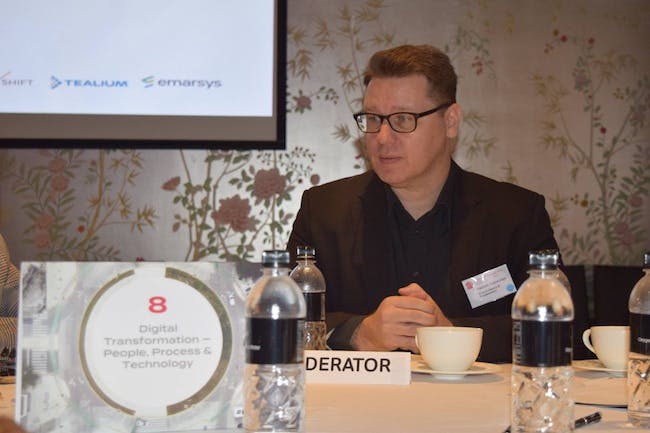But while digital transformation can seem like just another trend, marketers have been telling us for many years that digital transformation is a useful way to reorient the organisation around the customer and that many organisations now have sizable digital transformation programmes underway.
Yet, many senior executives at companies which would benefit from digital transformation remain unconvinced, in part because they, the people who should be driving transformation, still don’t fully understand what it means.
To help out, Econsultancy recently held roundtable discussions on Digital Transformation at its annual Digital Cream event in Singapore. At a table hosted by Damien Cummings, CEO of Peoplewave and entrepreneur-in-residence at Econsultancy APAC, marketers experienced with digital transformation discussed the questions they had on the topic before they started along with some helpful answers.
1) What exactly is digital transformation?
Roundtable participants agreed that it is difficult to define ‘digital transformation’ because the scope of a transformation project depends on the company, the industry in which it operates and its business needs.
Instead, as suggested in previous Econsultancy posts, organisations should look at where they want to get to and define transformation as the process they need to take to get there.
For most, the destination is to be a ‘digital organisation’ which:
- Focuses on customer experience irrespective of channel, and
- Leverages digital technology to achieve that goal.
Those looking for more information on defining digital transformation encouraged to read:
- The essential first step toward digital transformation
- One of Econsultancy’s digital transformation case studies
- Or a best practice guide

2) How do digital transformation projects get started?
While many at the table said that they became interested in transformation as a way to fast-forward their company into the ‘digital era’, most admitted that the key driver for digital transformation was to cut costs. As this is often the CEO’s perspective, participants advised those aiming to get started to focus on the cost-reduction benefits of digital transformation over anything else.
Rarely, the table agreed, was digital transformation started by promising an improved customer experience or revenue growth. One exception to this was to move a traditional retailer or brand to omnichannel which had the potential to both directly engage consumers digitally and provide new markets for a brand.
3) What can DT project members do to engage stakeholders?
First off, participants said, the transformation team has to realise that digital transformation is about people, not technology. Because of this, personal relationships are key to the success of transformation.
Unfortunately, according to delegates, people on the transformation team tend to be relatively junior and do not have the senior stakeholder relationships that they need.
One participant said they overcame this obstacle by simply being ‘likable’. Team members worked on building personal relationships with people in the c-suite and providing progress updates.
Once the c-suite is bought in to the project, another attendee suggested, the transformation leaders can build wider support by having senior stakeholders attend, and thereby endorse, big presentations about digital transformation to the whole organisation.

4) How can the transformation team keep up the momentum?
Another issue faced by those experienced with digital transformation was keeping up the momentum of the project. Everything starts well, they said, but after a few months, people tend to lose interest and enthusiasm.
To maintain urgency, attendees were advised to keep in continuous communication with stakeholders, but to avoid marketing speak. Don’t mention things like ‘impressions’, ‘conversions’ or even ‘brand’ with business sponsors, one expert suggested, but instead talk about commercially-focused outcome of the transformation. Most people in the organisation don’t understand marketing, they concluded, but everyone understands ‘revenue’ and ‘profit’.
Also, participants said that the team can ‘light a fire’ under senior management by pointing at competitors who have either successfully launched digital transformation or failed to do so. This, said one attendee, will help unite a team around a single goal (i.e. do it better than the competition) and overcome internal resistance.
5) What is the biggest obstacle DT programmes run into?
Finally, delegates discussed what was not working with their digital transformation programs – and how they are trying to overcome these obstacles.
Continuing from the previous point, attendees said that the main problem they faced was the ‘frozen middle’. As one participant said, once they were able to get senior people engaged with the project, junior people were relatively easier to win over. But there were many people ‘in the middle’ who couldn’t find anything for them in digital transformation and, consequently, would resist many of the changes.
This, said another, is the source of most of the obstacles encountered during digital transformation. Data silos, slow sign-offs and seemingly endless planning sessions all occur because of the “WIIFM” (what’s in it for me?) attitude at the mid-level of many organisations.
To overcome this, marketers were encouraged to always consider the ‘frozen middle’ and include a WIIFY (what’s in it for you) section of their roadmap presentations.
Digital transformation, attendees were reminded, is not only about digital. In fact, it’s largely about change management and, most of all, people.

A word of thanks
Econsultancy would like to thank Damien Cummings, CEO of Peoplewave and entrepreneur-in-residence at Econsultancy APAC for hosting the Digital Transformation table and providing valuable, real-world examples for participants. We’d also like to thank all of the marketers who attended and provided their insights about how digital transformation is going at their respective companies.
We hope to see you all at future Econsultancy APAC events!

Comments